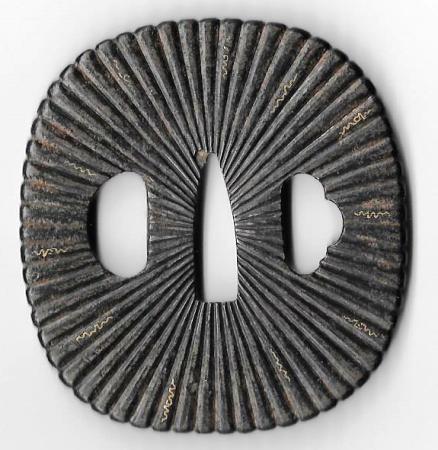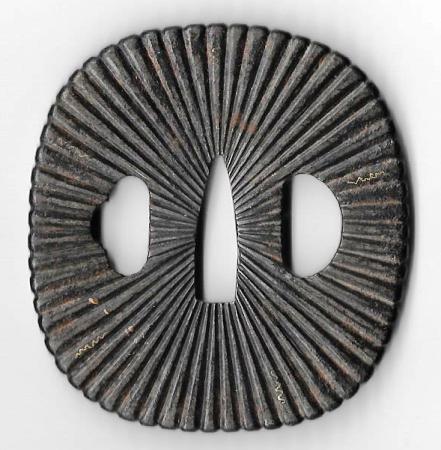Fuyohiro Handachi Wakizashi
S0372
Sold
A suriage koto wakizashi signed nijimei, Fuyohiro. Shinogizukure, toriizori, iroi mune, chu kissaki. Hawatare: 1 shaku 8 sun 4 bu 5 rin (56.2 cm / 22.125"). Motohaba: 2.5 cm. Sakihaba: 1.47 cm. Kasane: 5.34 mm. Gunome midare in nie deki. Starting with shallow gunome notare in a suguba, becoming o-gunome as the hamon progresses toward the front. Sunagashi, kinsuji, ha nie, nado. The boshi is a slightly irregular komaru, that looks like it was tempted to be a jizo. The jigane is a loosely forged itame nagare, jinie, chikei nado. The sword is in good old polish.
The iron handachi mounted cinnabar saya has some chipping along the seam, horn kurikata; The tsuka is a leather maki, over good quality same; with plain iron fuchi-kashira, that appear to be Higo. Shakudo menuki of a man in a boat. The tsuba is in excellent condition, of a sixty-four petal chrysanthemum, with gold highlights. The habaki is silver foil over copper. The tsuba indicates an allegiance to the emperor, during a time when the Tokugawa were in complete control, and the imperial household had little wealth, and less power. Cinnabar saya were common in the southern provinces, Satsuma, Choshu, Higo, which was the seat of the Meiji restoration.
There were numerous smith who signed Fuyohiro. This is the work of a Mino smith, working in late Muromachi, around 1550. At this time, because of the style of fighting, long wakizashi from Bizen and Mino were used as uchigatana.
$1,550
Nijimei, Fuyohiro
Leather tsukamaki


Sixty-four Petal Chrysanthemum Tsuba
A little ahead of the machi
Slightly further toward the front
Pattern starting midway